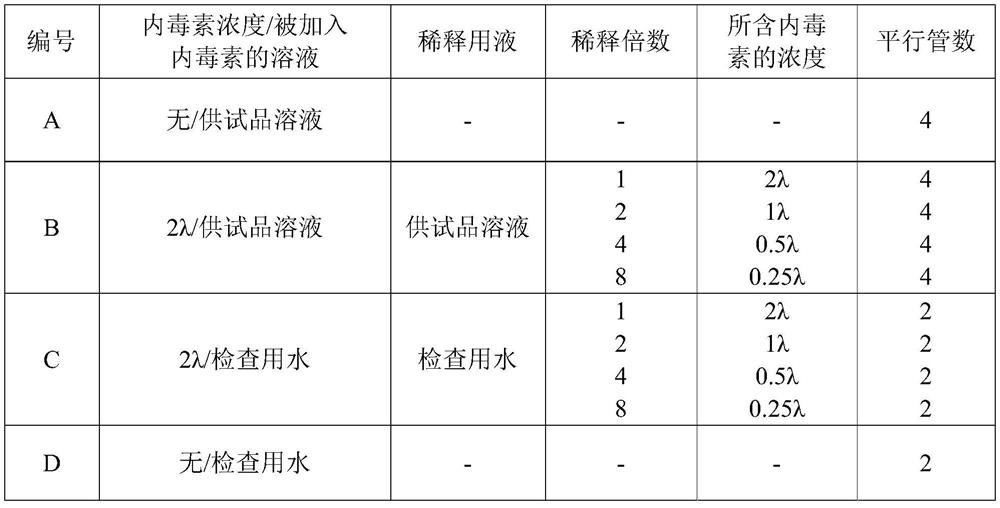Method for detecting bacterial endotoxin in dexmedetomidine hydrochloride by gel process
A technology for dexmedetomidine hydrochloride and bacterial endotoxin, which is applied in the field of drug analysis, can solve the problems of affecting the recovery of bacterial endotoxin, the recovery rate is less than 50%, and low popularity, so as to achieve accurate and reliable detection results and low detection cost , The effect of eliminating interference
- Summary
- Abstract
- Description
- Claims
- Application Information
AI Technical Summary
Problems solved by technology
Method used
Image
Examples
Embodiment 1
[0051] 1. Solution preparation
[0052] 1. Dilution of the test solution
[0053] Weigh about 10 mg of dexmedetomidine hydrochloride, add about 1 mL of DMSO, completely dissolve and mix to obtain a 10 mg / mL dexmedetomidine hydrochloride DMSO solution. Finally, use diluent I and BET water, and gradually dilute to the test solution of 0.3mg / mL (2c) and 0.15mg / mL (c) according to the following dilution methods. In the need testing solution of 0.15mg / mL (c), the volume concentration of DMSO is 1.5%, and the volume concentration of diluent I is 23.5%.
[0054]
[0055] 2. Preparation of Bacterial Endotoxin Standards
[0056] Dissolve 1 bacterial endotoxin standard in BET water, mix continuously with a vortex mixer for 20-30 minutes, dilute with BET water, and mix for at least 30 seconds before proceeding to the next dilution. Diluted successively to 0.03EU / mL (2λ),
[0057] 0.015EU / mL (λ), 0.0075EU / mL (0.5λ), 0.00375EU / mL (0.25λ).
[0058] 3. Preparation of Bacterial Endoto...
Embodiment 2
[0081] 1. Solution preparation
[0082] 1. Dilution of the test solution
[0083]Weigh about 10 mg of dexmedetomidine hydrochloride, add about 1 mL of DMSO, completely dissolve and mix to obtain a 10 mg / mL dexmedetomidine hydrochloride DMSO solution. Finally, use diluent I and BET water, and gradually dilute to the test solution of 0.3mg / mL (2c) and 0.15mg / mL (c) according to the following dilution methods. In the need testing solution of 0.15mg / mL (c), the volume concentration of DMSO is 2.25%, and the volume concentration of diluent I is 47.75%.
[0084]
[0085] 2. Preparation of Bacterial Endotoxin Standards
[0086] Referring to Example 1.
[0087] 3. Preparation of Bacterial Endotoxin Test Solution
[0088] Referring to Example 1.
[0089] 2. Limulus reagent interference test
[0090] 1. Test process
[0091] Take 30 tubes of Limulus reagent (0.015EU / mL) dissolved in BET water, 0.1 mL per tube. Add 2λ, λ, 0.5λ, 0.25λ concentrations of bacterial endotoxin stand...
Embodiment 3 2
[0135] Embodiment 3 dimethyl sulfoxide (DMSO) interference test
[0136] Tests in Example 1 confirm that using DMSO-dissolved dexmedetomidine hydrochloride to prepare 10 mg / mL dexmedetomidine hydrochloride solution, adding an appropriate amount of diluent I in the subsequent dilution process will not cause the sample to separate out, and can eliminate dexmedetomidine hydrochloride Interfering effect of detomidine on detection of bacterial endotoxin.
[0137] In order to verify whether the above-mentioned DMSO addition method and the amount itself will destroy the bacterial endotoxin, DMSO also carried out 1 interference pre-test and 3 interference tests.
[0138] 1. DMSO interference pre-test
[0139] 1. Preparation of the test solution: Take DMSO and gradually dilute it with BET water to obtain dilutions with DMSO concentrations of 20%, 10%, 5%, 2.5%, and 1.25%, respectively, and record this series of solutions as NPC.
[0140] 2. Preparation of bacterial endotoxin standard...
PUM
| Property | Measurement | Unit |
|---|---|---|
| concentration | aaaaa | aaaaa |
Abstract
Description
Claims
Application Information
 Login to View More
Login to View More - R&D
- Intellectual Property
- Life Sciences
- Materials
- Tech Scout
- Unparalleled Data Quality
- Higher Quality Content
- 60% Fewer Hallucinations
Browse by: Latest US Patents, China's latest patents, Technical Efficacy Thesaurus, Application Domain, Technology Topic, Popular Technical Reports.
© 2025 PatSnap. All rights reserved.Legal|Privacy policy|Modern Slavery Act Transparency Statement|Sitemap|About US| Contact US: help@patsnap.com



